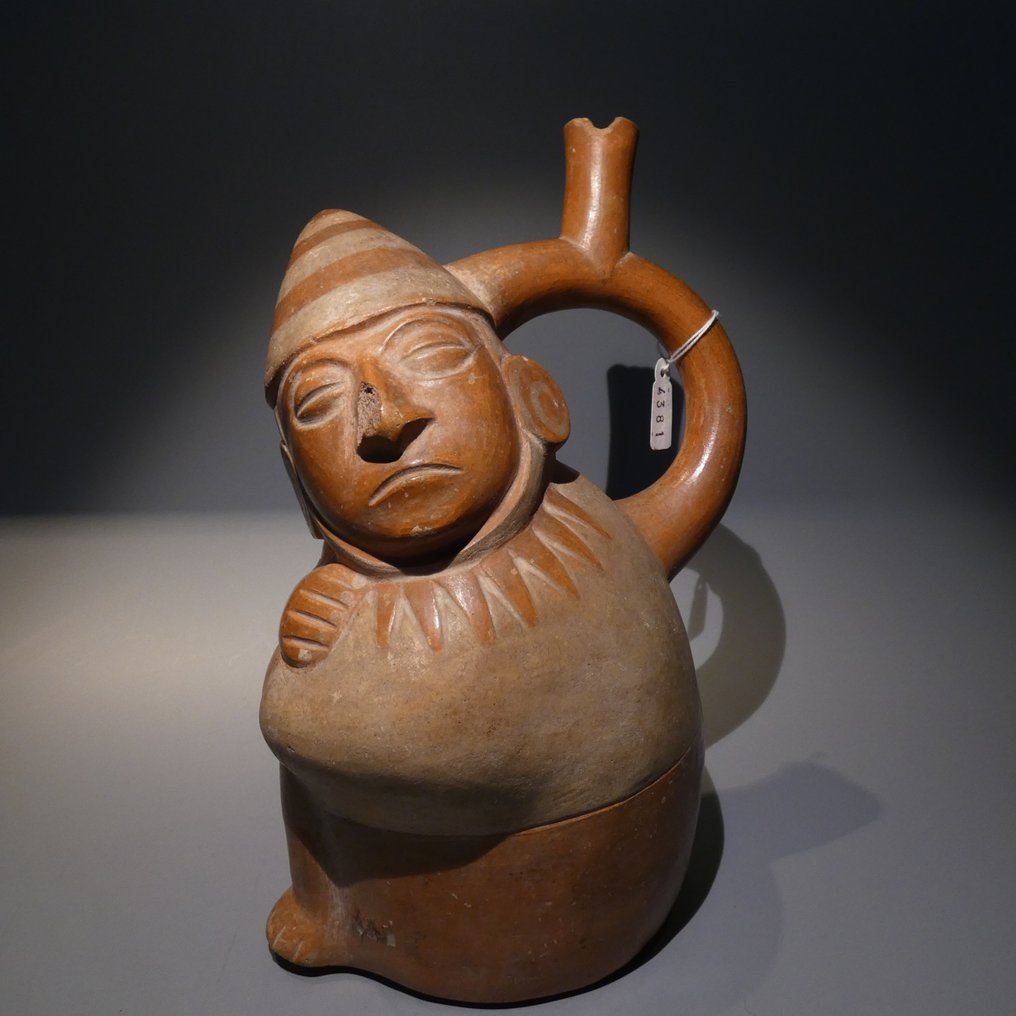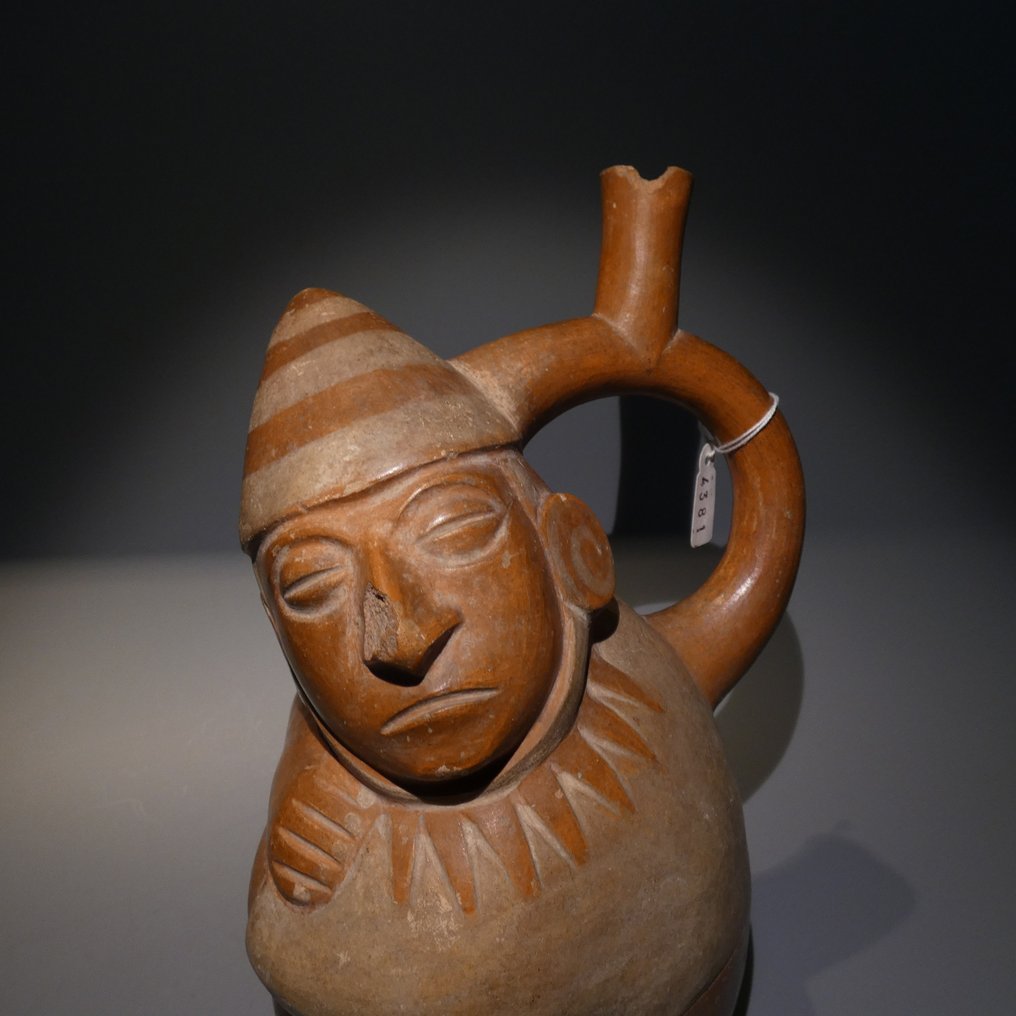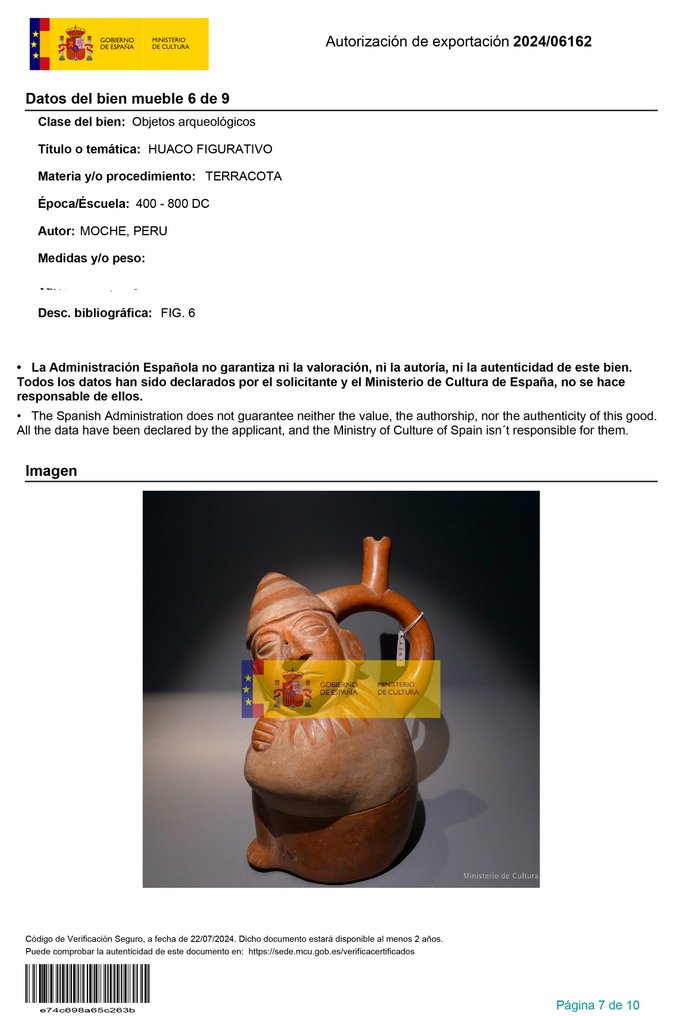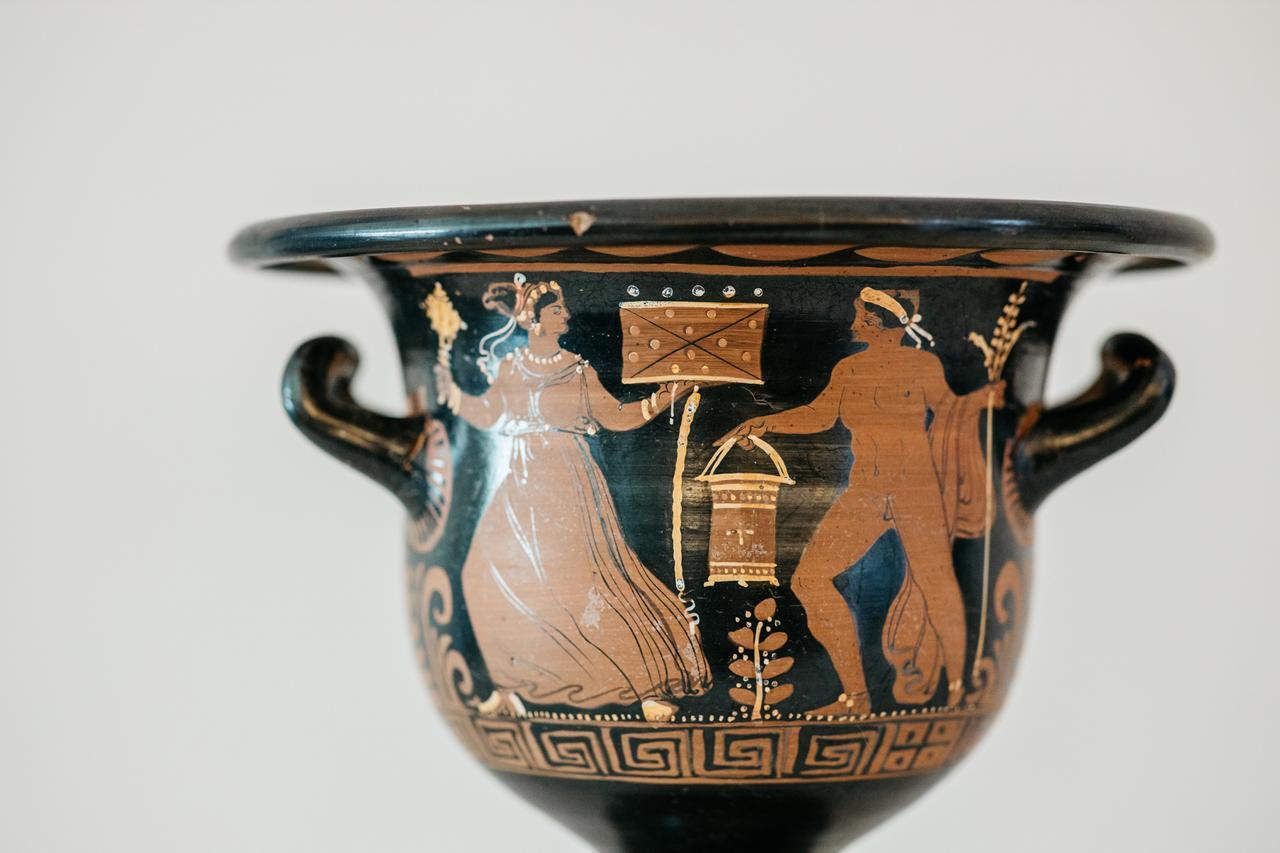Moche, Peru Terrakotta Finom Huaco főfigura. 23 cm magas. Kr. u. 400 - 800. Spanyol exportengedély.






Az Ifergan Gyűjtemény Múzeumának vezetője, föníciai régészet szakértője.
Catawiki Vevővédelem
A befizetést biztonságban megőrizzük, amíg a termék kézbesítése meg nem történik. Részletek megtekintése
Trustpilot 4.4 | 122473 vélemény
A Trustpilot-on kiváló értékelésű.
Moche terrakotta Huaco vezérfigura, 23 cm magas, 400–800 körül, spanyol exportengedéllyel, magángyűjteményből.
Leírás az eladótól
Finom kantáros korsó, Huaco figurája egy főnökről.
Moche, Peru, i.sz. 400 - 800.
Terrakotta és pigmentek
23 cm magasság
Eredet
Magángyűjtemény, J. R. (1928 - 2013) Barcelona, 1950-től 2000-ig alakult. Ezután utód által. A gyűjtemény régi címkéje a 4381-es számú.
DOKUMENTUMOK:
Spanyol exportengedély
Jó állapotban, lásd a fényképeket.
A Moche kultúra a mai észak-perui part mentén élt, különösen a Lambayeque, Chicama, Moche és Virú völgyeiben. Ez a sivatagi régió több folyón keresztül áramlik a Csendes-óceánba, ahol gazdag tengeri erőforrások találhatók.
A Moche kiváló kerámiát, textíliákat és drágaköveket készített. Jellegzetes stílusukat számos tárgyon meg lehet figyelni, például tűzkarcolt tökökön, falfestményeken, tollművészeten, testfestésen és tetoválásokon. Kerámiáik díszítése olyan szintű szakértelmet mutat, amelyet ritkán haladnak meg, ideértve az vágást, bélyegzett aláfestést és sima felületeken való festést. Sok darab állami műhelyekben készült, ahol formákból tömegesen gyártottak alkotásokat. Kerámiáik különböző formákban és díszítő stílusokban készültek, és mitológiai és rituális motívumokat is bemutattak. Különösen figyelemre méltóak voltak az úgynevezett „portrépalackok”, amelyek jól ismert Moche személyiség arcával voltak formázva. Ezek a rendkívül részletes arcképek tükrözik a Moche saját arcfestését és/vagy tetoválásait, valamint az összetett fejdíszeket. Ez a portrékészítési szakértelem megfigyelhető mind a mindennapi jelenetekben, mind az erotikus ábrázolásokban, valamint olyan személyek alakjában, akik görbe hátúak, vakok vagy más rendellenességgel küzdöttek. Kiváló aranyművesek voltak, aranyat, rézet és ezüstöt használtak ékszerek, orrkarikák, karkötők, nyakláncgyöngyök, csipeszek és különféle eszközök készítéséhez. Különösen figyelemre méltó a tumi vagy ceremónia kés, amelyet általában csak a Moche hivatalnokai hordtak.
A Moche kerámiák részletes ábrázolásokat nyújtanak a kultúra természetfeletti világáról, beleértve az istenségeket, mítoszokat, szent állatokat és szertartási szokásokat. Az istenségeik rókák, baglyok, kolibrik, héják és nagymacskák alakját öltik. Ezek a figurák a nagyobb istenek szolgái voltak, akik emberi formában jelentek meg, díszes öltözékeket viseltek, és vad arcukat keresztbe tett fogakkal díszítették.
A fontos Moche személyek sírjai téglalap alakúak voltak, és adobe anyagból készültek, szentélyekkel az áldozatok számára. Egyes testeket nádszőnyegre fektettek, míg másokat barlangokban, nádsírban hagytak. A kiváltságos osztály tagjait fémmaszkokkal és gazdag sírkövekkel temették el, szolgákkal és állatokkal kísérve őket. A híres „Sipán Ura” a legnevezetesebb példája ennek a temetkezési módnak.
A darab tartalmaz hitelesítési tanúsítványt.
- A darab spanyol exportengedélyt (útlevelet az Európai Unióba) tartalmaz. ADÓT NEM.
A spanyol jogszabályok szerint az Európai Unióon kívül küldött tételek kivitelre vonatkozó adók alá esnek, amelyek a számlán kerülnek felszámításra a vásárló költségén. Ezek az exportdíjak a végső aukciós ár alapján fixáltak, és az adókulcs nem közvetlenül az exportálandó tétel összértékére alkalmazandó, hanem különböző százalékokat alkalmaznak rá a szekciókra.
- 6000 euróig: 5%.
- 6 001 és 60 000 euró között: 10%.
Ez az exportengedély-igénylési folyamat legfeljebb 1-2 hónapot vehet igénybe.
Az eladó garantálja, hogy ezt a darabot a kulturális tulajdonjogon alapuló összes nemzeti és nemzetközi jogszabálynak megfelelően szerezte be. A származási nyilatkozatot a Catawiki látta.
Az eladó története
Finom kantáros korsó, Huaco figurája egy főnökről.
Moche, Peru, i.sz. 400 - 800.
Terrakotta és pigmentek
23 cm magasság
Eredet
Magángyűjtemény, J. R. (1928 - 2013) Barcelona, 1950-től 2000-ig alakult. Ezután utód által. A gyűjtemény régi címkéje a 4381-es számú.
DOKUMENTUMOK:
Spanyol exportengedély
Jó állapotban, lásd a fényképeket.
A Moche kultúra a mai észak-perui part mentén élt, különösen a Lambayeque, Chicama, Moche és Virú völgyeiben. Ez a sivatagi régió több folyón keresztül áramlik a Csendes-óceánba, ahol gazdag tengeri erőforrások találhatók.
A Moche kiváló kerámiát, textíliákat és drágaköveket készített. Jellegzetes stílusukat számos tárgyon meg lehet figyelni, például tűzkarcolt tökökön, falfestményeken, tollművészeten, testfestésen és tetoválásokon. Kerámiáik díszítése olyan szintű szakértelmet mutat, amelyet ritkán haladnak meg, ideértve az vágást, bélyegzett aláfestést és sima felületeken való festést. Sok darab állami műhelyekben készült, ahol formákból tömegesen gyártottak alkotásokat. Kerámiáik különböző formákban és díszítő stílusokban készültek, és mitológiai és rituális motívumokat is bemutattak. Különösen figyelemre méltóak voltak az úgynevezett „portrépalackok”, amelyek jól ismert Moche személyiség arcával voltak formázva. Ezek a rendkívül részletes arcképek tükrözik a Moche saját arcfestését és/vagy tetoválásait, valamint az összetett fejdíszeket. Ez a portrékészítési szakértelem megfigyelhető mind a mindennapi jelenetekben, mind az erotikus ábrázolásokban, valamint olyan személyek alakjában, akik görbe hátúak, vakok vagy más rendellenességgel küzdöttek. Kiváló aranyművesek voltak, aranyat, rézet és ezüstöt használtak ékszerek, orrkarikák, karkötők, nyakláncgyöngyök, csipeszek és különféle eszközök készítéséhez. Különösen figyelemre méltó a tumi vagy ceremónia kés, amelyet általában csak a Moche hivatalnokai hordtak.
A Moche kerámiák részletes ábrázolásokat nyújtanak a kultúra természetfeletti világáról, beleértve az istenségeket, mítoszokat, szent állatokat és szertartási szokásokat. Az istenségeik rókák, baglyok, kolibrik, héják és nagymacskák alakját öltik. Ezek a figurák a nagyobb istenek szolgái voltak, akik emberi formában jelentek meg, díszes öltözékeket viseltek, és vad arcukat keresztbe tett fogakkal díszítették.
A fontos Moche személyek sírjai téglalap alakúak voltak, és adobe anyagból készültek, szentélyekkel az áldozatok számára. Egyes testeket nádszőnyegre fektettek, míg másokat barlangokban, nádsírban hagytak. A kiváltságos osztály tagjait fémmaszkokkal és gazdag sírkövekkel temették el, szolgákkal és állatokkal kísérve őket. A híres „Sipán Ura” a legnevezetesebb példája ennek a temetkezési módnak.
A darab tartalmaz hitelesítési tanúsítványt.
- A darab spanyol exportengedélyt (útlevelet az Európai Unióba) tartalmaz. ADÓT NEM.
A spanyol jogszabályok szerint az Európai Unióon kívül küldött tételek kivitelre vonatkozó adók alá esnek, amelyek a számlán kerülnek felszámításra a vásárló költségén. Ezek az exportdíjak a végső aukciós ár alapján fixáltak, és az adókulcs nem közvetlenül az exportálandó tétel összértékére alkalmazandó, hanem különböző százalékokat alkalmaznak rá a szekciókra.
- 6000 euróig: 5%.
- 6 001 és 60 000 euró között: 10%.
Ez az exportengedély-igénylési folyamat legfeljebb 1-2 hónapot vehet igénybe.
Az eladó garantálja, hogy ezt a darabot a kulturális tulajdonjogon alapuló összes nemzeti és nemzetközi jogszabálynak megfelelően szerezte be. A származási nyilatkozatot a Catawiki látta.
Az eladó története
Részletek
Lemondás
Az eladó tájékoztatást kapott a Catawiki-től a dokumentációs követelményekről, és a következőket garantálja: - a tárgyat jogszerűen szerezték meg, - az eladó jogosult az adott tárgyat eladni és/vagy exportálni, - az eladó biztosítja a szükséges származási információkat, és gondoskodik a szükséges dokumentumokról és engedélyekről/licencekről, amennyiben azok szükségesek és a helyi jogszabályok szerint előírtak. - az eladó értesíti a vevőt az engedélyek/licencek megszerzésének bármilyen késedelméről. A licitálással Ön tudomásul veszi, hogy lakóhelye országától függően importdokumentációra lehet szükség, és hogy az engedélyek/licencek megszerzése késedelmet okozhat a tárgy szállításában.
Az eladó tájékoztatást kapott a Catawiki-től a dokumentációs követelményekről, és a következőket garantálja: - a tárgyat jogszerűen szerezték meg, - az eladó jogosult az adott tárgyat eladni és/vagy exportálni, - az eladó biztosítja a szükséges származási információkat, és gondoskodik a szükséges dokumentumokról és engedélyekről/licencekről, amennyiben azok szükségesek és a helyi jogszabályok szerint előírtak. - az eladó értesíti a vevőt az engedélyek/licencek megszerzésének bármilyen késedelméről. A licitálással Ön tudomásul veszi, hogy lakóhelye országától függően importdokumentációra lehet szükség, és hogy az engedélyek/licencek megszerzése késedelmet okozhat a tárgy szállításában.
